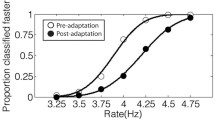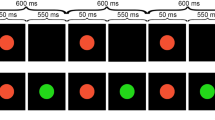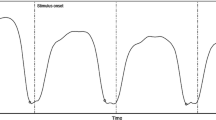Abstract
Timing is essential for various behaviors and relative to vision, audition is considered to be specialized for temporal processing. The present study conducted a sensorimotor timing task that required tapping in synchrony with a temporally regular sequence and a perceptual timing task that required detecting a timing deviation among a temporally regular sequence. The sequence was composed of auditory tones, visual flashes, or a visual bouncing ball. In the sensorimotor task, sensorimotor timing performance (synchronization stability) of the bouncing ball was much greater than that of flashes and was comparable to that of tones. In the perceptual task, where perceptual timing performance of the bouncing ball was greater than that of flashes, it was poorer than that of tones. These results suggest the facilitation of both perceptual and sensorimotor processing of temporal information by the bouncing ball. Given such facilitation of temporal processing, however, audition is still superior over vision in perceptual detection of timing.


Similar content being viewed by others
References
Abrams, R. A., & Christ, S. E. (2003). Motion onset captures attention. Psychological Science, 14, 427–432.
Armstrong, A., Issartel, J., Varlet, M., & Marin, L. (2013). The supplementation of spatial information improves coordination. Neuroscience Letters, 548, 212–216.
Berens, P. (2009). CircStat: A MATLAB toolbox for circular statistics. Journal of Statistical Software, 31, 1–21.
Celma-Miralles, A., de Menezes, R. F., & Toro, J. M. (2016). Look at the beat, feel the meter: Top-down effects of meter induction on auditory and visual modalities. Frontiers in Human Neuroscience, 10, 108.
Chen, L., & Vroomen, J. (2013). Intersensory binding across space and time: A tutorial review. Attention, Perception, & Psychophysics, 75, 790–811.
Colley, I. D., Varlet, M., MacRitchie, J., & Keller, P. E. (2018). The influence of visual cues on temporal anticipation and movement synchronization with musical sequences. Acta Psychologica, 191, 190–200.
Costall, A. P. (1984). Are theories of perception necessary? A review of Gibson’s the ecological approach to visual perception. Journal of the Experimental Analysis of Behavior, 41, 109–115.
Dalla Bella, S., & Sowiński, J. (2015). Uncovering beat deafness: detecting rhythm disorders with synchronized finger tapping and perceptual timing tasks. Journal of Visualized Experiments. https://doi.org/10.3791/51761.
Eagleman, D. M., Tse, P. U., Buonomano, D., Janssen, P., Nobre, A. C., & Holcombe, A. O. (2005). Time and the brain: How subjective time relates to neural time. Journal of Neuroscience, 25, 10369–10371.
Faul, F., Erdfelder, E., Lang, A.-G., & Buchner, A. (2007). G*Power 3: A flexible statistical power analysis program for the social, behavioral, and biomedical sciences. Behavior Research Methods, 39, 175–191.
Fisher, N. I. (1993). Statistical Analysis of Circular Data. Cambridge: Cambridge University Press.
Fujii, S., & Schlaug, G. (2013). The Harvard Beat Assessment Test (H-BAT): A battery for assessing beat perception and production and their dissociation. Frontiers in Human Neuroscience, 7, 771.
Gan, L., Huang, Y., Zhou, L., Qian, C., & Wu, X. (2015). Synchronization to a bouncing ball with a realistic motion trajectory. Scientific Reports, 5, 11974.
Gibson, J. J. (1979). The Ecological Approach to Visual Perception. Boston: Houghton Mifflin.
Grahn, J. A., Henry, M. J., & McAuley, J. D. (2011). FMRI investigation of cross-modal interactions in beat perception: Audition primes vision, but not vice versa. NeuroImage, 54, 1231–1243.
Grahn, J. A., & Rowe, J. B. (2009). Feeling the Beat: Premotor and Striatal Interactions in Musicians and Nonmusicians during Beat Perception. Journal of Neuroscience, 29, 7540–7548.
Grube, M., Cooper, F. E., Chinnery, P. F., & Griffiths, T. D. (2010). Dissociation of duration-based and beat-based auditory timing in cerebellar degeneration. Proceedings of the National Academy of Sciences, 107, 11597–11601.
Guttman, S. E., Gilroy, L. A., & Blake, R. (2005). Hearing what the eyes see: Auditory encoding of visual temporal sequences. Psychological Science, 16, 228–235.
Holcombe, A. O. (2009). Seeing slow and seeing fast: Two limits on perception. Trends in Cognitive Sciences, 13, 216–221.
Hove, M. J., Fairhurst, M. T., Kotz, S. A., & Keller, P. E. (2013a). Synchronizing with auditory and visual rhythms: An fMRI assessment of modality differences and modality appropriateness. NeuroImage, 67, 313–321.
Hove, M. J., Iversen, J. R., Zhang, A., & Repp, B. H. (2013b). Synchronization with competing visual and auditory rhythms: Bouncing ball meets metronome. Psychological Research, 77, 388–398.
Hove, M. J., Spivey, M. J., & Krumhansl, C. L. (2010). Compatibility of motion facilitates visuomotor synchronization. Journal of Experimental Psychology: Human Perception and Performance, 36, 1525–1534.
Huang, Y., Gu, L., Yang, J., Zhong, S., & Wu, X. (2018). Relative contributions of the speed characteristic and other possible ecological factors in synchronization to a visual beat consisting of periodically moving stimuli. Frontiers in Psychology, 9, 1226.
Iversen, J. R., & Balasubramaniam, R. (2016). Synchronization and temporal processing. Current Opinion in Behavioral Sciences, 8, 175–180.
Iversen, J. R., Patel, A. D., Nicodemus, B., & Emmorey, K. (2015). Synchronization to auditory and visual rhythms in hearing and deaf individuals. Cognition, 134, 232–244.
Ivry, R. B. (1996). The representation of temporal information in perception and motor control. Current Opinion in Neurobiology, 6, 851–857.
Kilner, J., de Hamilton, A. F. C., & Blakemore, S.-J. (2007). Interference effect of observed human movement on action is due to velocity profile of biological motion. Social Neuroscience, 2, 158–166.
Kleiner, M., Brainard, D., Pelli, D., Ingling, A., Murray, R., & Broussard, C. (2007). What’s new in psychtoolbox-3. Perception, 36, 1–16.
Lakens, D. (2013). Calculating and reporting effect sizes to facilitate cumulative science: a practical primer for t tests and ANOVAs. Frontiers in Psychology, 4, 863.
Large, E. W., & Jones, M. R. (1999). The dynamics of attending: How people track time-varying events. Psychological Review, 106, 119–159.
Lerdahl, F., & Jackendoff, R. (1983). An overview of hierarchical structure in music. Music Perception, 1, 229–252.
Manning, F., & Schutz, M. (2013). “Moving to the beat” improves timing perception. Psychonomic Bulletin & Review, 20, 1133–1139.
Mauk, M. D., & Buonomano, D. V. (2004). The neural basis of temporal processing. Annual Review of Neuroscience, 27, 307–340.
Milner, D., & Goodale, M. (2006). The visual brain in action (2nd ed.). Oxford: Oxford University Press.
Mu, Y., Huang, Y., Ji, C., Gu, L., & Wu, X. (2018). Auditory over visual advantage of sensorimotor synchronization in 6- to 7-year-old children but not in 12- to 15-year-old children and adults. Journal of Experimental Psychology: Human Perception and Performance, 44, 818–826.
Patel, A. D. (2014). The evolutionary biology of musical rhythm: Was Darwin Wrong? PLoS Biology, 12, e1001821.
Patel, A. D., & Iversen, J. R. (2014). The evolutionary neuroscience of musical beat perception: the Action Simulation for Auditory Prediction (ASAP) hypothesis. Frontiers in Systems Neuroscience, 8, 57.
Patel, A. D., Iversen, J. R., Chen, Y., & Repp, B. (2005). The influence of metricality and modality on synchronization with a beat. Experimental Brain Research, 163, 226–238.
Povel, D.-J., & Essens, P. (1985). Perception of temporal patterns. Music Perception, 2, 411–440.
Repp, B. H. (2002). Perception of timing is more context sensitive than sensorimotor synchronization. Perception & Psychophysics, 64, 703–716.
Repp, B. H. (2005). Sensorimotor synchronization: A review of the tapping literature. Psychonomic Bulletin & Review, 12, 969–992.
Repp, B. H., & Penel, A. (2002). Auditory dominance in temporal processing: new evidence from synchronization with simultaneous visual and auditory sequences. Journal of Experimental Psychology: Human Perception and Performance, 28, 1085–1099.
Repp, B. H., & Penel, A. (2004). Rhythmic movement is attracted more strongly to auditory than to visual rhythms. Psychological Research, 68, 252–270.
Repp, B. H., & Su, Y.-H. (2013). Sensorimotor synchronization: A review of recent research (2006–2012). Psychonomic Bulletin & Review, 20, 403–452.
Silva, S., & Castro, S. L. (2016). Moving stimuli facilitate synchronization but not temporal perception. Frontiers in Psychology, 7, 1798.
Stanislaw, H., & Todorov, N. (1999). Calculation of signal detection theory measures. Behavior Research Methods, Instruments, & Computers, 31, 137–149.
Su, Y.-H. (2016). Sensorimotor synchronization with different metrical levels of point-light dance movements. Frontiers in Human Neuroscience, 10, 186.
Su, Y.-H., & Pöppel, E. (2012). Body movement enhances the extraction of temporal structures in auditory sequences. Psychological Research, 76, 373–382.
Teki, S., Grube, M., Kumar, S., & Griffiths, T. D. (2011). Distinct neural substrates of duration-based and beat-based auditory timing. Journal of Neuroscience, 31, 3805–3812.
Ungerleider, L. G., & Mishkin, M. (1982). Two cortical visual systems. In D. J. Ingle, M. A. Goodale, & R. J. W. Mansfield (Eds.), Analysis of visual behavior (pp. 549–586). Cambridge: MIT Press.
Varlet, M., Coey, C. A., Schmidt, R. C., Marin, L., Bardy, B. G., & Richardson, M. J. (2014). Influence of stimulus velocity profile on rhythmic visuomotor coordination. Journal of Experimental Psychology: Human Perception and Performance, 40, 1849–1860.
Varlet, M., Marin, L., Issartel, J., Schmidt, R. C., & Bardy, B. G. (2012). Continuity of visual and auditory rhythms influences sensorimotor coordination. PLoS One, 7, e44082.
Varlet, M., Schmidt, R. C., & Richardson, M. J. (2017). Influence of stimulus velocity profile on unintentional visuomotor entrainment depends on eye movements. Experimental Brain Research, 235, 3279–3286.
Vorberg, D., & Wing, A. (1996). Modeling variability and dependence in timing. In H. Heuer & S. W. Keele (Eds.), Handbook of perception and action (pp. 181–262). London: Academic Press.
Wu, X., Ashe, J., & Bushara, K. O. (2011). Role of olivocerebellar system in timing without awareness. PNAS, 108, 13818–13822.
Zatorre, R. J., Chen, J. L., & Penhune, V. B. (2007). When the brain plays music: auditory-motor interactions in music perception and production. Nature Reviews Neuroscience, 8, 547–558.
Zelic, G., Varlet, M., Kim, J., & Davis, C. (2016). Influence of pacer continuity on continuous and discontinuous visuo-motor synchronisation. Acta Psychologica, 169, 61–70.
Zelic, G., Varlet, M., Wishart, J., Kim, J., & Davis, C. (2018). The dual influence of pacer continuity and pacer pattern for visuomotor synchronisation. Neuroscience Letters, 683, 150–159.
Acknowledgements
This work was supported by National Natural Science Foundation of China (31371129) and Research Project of Sun Yat-Sen University (26000-31620003).
Author information
Authors and Affiliations
Contributions
GL, HYY, and WX designed the research; GL and HYY performed the research and analyzed the data; and WX wrote the manuscript.
Corresponding author
Ethics declarations
Conflict of interest
The authors declare no competing financial interest.
Data availability
The data generated during and/or analyzed during the current study are available from the corresponding author on reasonable request.
Additional information
Publisher's Note
Springer Nature remains neutral with regard to jurisdictional claims in published maps and institutional affiliations.
Electronic supplementary material
Below is the link to the electronic supplementary material.
Rights and permissions
About this article
Cite this article
Gu, L., Huang, Y. & Wu, X. Advantage of audition over vision in a perceptual timing task but not in a sensorimotor timing task. Psychological Research 84, 2046–2056 (2020). https://doi.org/10.1007/s00426-019-01204-3
Received:
Accepted:
Published:
Issue Date:
DOI: https://doi.org/10.1007/s00426-019-01204-3




